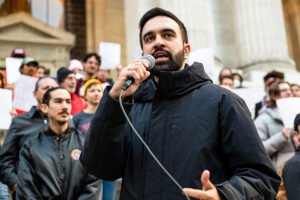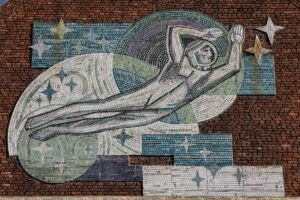
US democracy is in rough shape, and voters know it. According to a recent NPR/PBS NewsHour/Marist poll, Americans rank preserving democracy as the second-most important issue facing the country today, behind only the evergreen concern about the economy. Translating that broad worry into action is a challenge for civic institutions everywhere. If we are to turn things around, those of us in the civic field need to build a common set of goals and measures for a healthier public life.
Without good measurement, decisions are made based on theories rather than evidence. Evidence is necessary to help reduce the role of emotion and preconceived notions—and polarization—in decision-making. The work of civic repair includes a vast array of various practitioners, from multinational organizations to small community groups, and every one of them tracks the results of their work differently—if they track it at all.
Mapping Civic Measurement, a report by the Institute for Citizens & Scholars with funding from The College Board Foundation, draws on interviews with more than 70 researchers and practitioners and extensive resource analysis to determine what is working—and what is not—in measuring the civic knowledge, engagement, and attitudes of Americans. Collectively, are these organizations achieving the kind of civic improvement they want? Are there effective civic engagement strategies from one sector that might translate neatly into another? Civic measurements that reveal what works, what does not, and where there are gaps can guide investments toward the most significant impact.
If we are to turn things around, those of us in the civic field need to build a common set of goals and measures for a healthier public life.We cannot begin to answer those questions—let alone improve our shared work and inspire others to join—if we do not arrive at some consistent definition of terms and a set of measurements to define civic strength. One reason we do not have enough measurements of civic strength in the first place is that we lack a clear, common definition of what it means to be a good citizen today. At a moment of renewed interest in the nation’s shared public life, we have an opportunity to show where our time and resources can make the most difference.
The Need to Measure Opportunities for Civic Participation
Researchers often measure civic readiness by surveying people’s civic knowledge, skills, and disposition. (In practice, this mostly means measuring students’ civic knowledge since that’s easier to do.) They look much less at actual civic opportunities—the ways that citizens can participate in public life. But we are better at teaching civic knowledge than providing practical opportunities to use that knowledge. As a result, there is less of the latter to measure.
Students who receive any kind of civic education at all might be taught the three branches of the US government or the term lengths for US senators and representatives. But what do they do with that information? How does it inform their actions in public life? We can teach students how the US Supreme Court works, but young people need opportunities to put their civic knowledge into practice for it to feel meaningful. Student governments, guided debates, local public projects, and timely discussions of current events are all examples of where civic knowledge meets democratic practice.
We also need more examples of researchers measuring how people’s civic knowledge influences and is influenced by their civic opportunities. If, for instance, we only consider people’s fact-finding skills (civic readiness) and not their access to quality local journalism (civic opportunity), we cannot fully understand their readiness to be engaged participants in civic life.
Bringing together the disparate tools that measure civic readiness and civic opportunity in a simple and energizing way could provide a more concrete pathway to measuring civic readiness.
The Institute for Citizens & Scholars has developed a Civic Spring Fellowship that supports young people who design and work on their projects to address critical community needs, including mental health and economic opportunity. We measure the program’s effectiveness by how the gains in the Fellows’ civic readiness extend to the opportunities for them to be more effective citizens in their communities, such as advocating for policy changes to securing seats for youth on local government committees.
Civic Engagement Is Much More Than Voting
There is one area of civic participation that does get measured consistently, and that is voting. Voting is easy to measure and quantify. It is the civic element that is easiest to validate at scale. However, an overemphasis on measuring voting can oversimplify the many complex ways people engage civically, such as volunteering, joining community groups, and participating in the public square.
Civic readiness is a means to an end, namely civic participation. In this highly polarized era, measuring how people connect to others across political, social, economic, cultural, and religious differences is critical. When our researchers began their work on the report, they first considered three measurement areas: people’s civic knowledge, skills, and dispositions. In short: know, do, believe. Through research and interviews, our team realized they needed to consider a fourth measurement area: connect. When introducing that fourth category, we found that people’s civic connection with each other and their communities—including bridge-building across political differences—is not often measured.
Some cities have looked beyond voting as the main measure of civic engagement by asking about residents’ wellbeing and happiness. A decade ago, Bloomberg Philanthropies launched the Wellbeing Project, for which five US cities surveyed their residents to understand what the communities were doing well and how they could improve. In Santa Monica, CA, for instance, the initial findings revealed that many residents felt they had little influence on local decision-making. Similar measurement efforts have been adopted by cities across the country and around the world.
Sign up for our free newsletters
Subscribe to NPQ's newsletters to have our top stories delivered directly to your inbox.
By signing up, you agree to our privacy policy and terms of use, and to receive messages from NPQ and our partners.
Building on that work, Civic Health Project, an organization that aims to reduce polarization, has developed a free, open-source platform called the Social Cohesion Impact Measure. This tool measures the effects of bridge-building and depolarizing interventions. It includes surveys to assess bridging groups’ outcomes—such as how participants who identify as liberal feel about conservatives and vice versa. Over a dozen bridge-building groups, such as BridgeUSA and The Village Square, have adopted and used the Impact Measure, incorporating the tool to better quantify their work.
Only by working together will civic learning practitioners succeed in charting the path toward reduced polarization and a stronger democracy for all.
Dismantling Silos
So many civic learning practitioners are doing valuable work but are siloed. In our experience, researchers measuring readiness through secondary schools, higher education institutions, public libraries, and local governments do not partner with each other enough despite a shared mission to inform local decision-making. They each have a piece of the larger democracy puzzle, but there are significant gaps that more interaction and greater collaboration could help close.
Only by working together will civic learning practitioners succeed in charting the path toward reduced polarization and a stronger democracy for all. Researchers can shed light on commonalities across differences by discussing what they do and how they measure it. Practitioners of siloed topics (such as voting and civic education research) could coordinate more effectively, and we might even discover that we understand more than we now recognize.
Some forums that can bring practitioners together already exist. The National Conference on Citizenship, chartered by Congress in 1953, has built a network of partners focused on civic health, data, youth participation, misinformation, and more. Its signature event, the Annual Conference on Citizenship, advances the principles and practices of civic engagement. Tufts University hosts the Frontiers of Democracy Conference to convene practitioners and scholars. In communities around the country, the National Week of Conversation promotes dialogue and cooperation across ideological differences.
The insights we glean from civic measurement will help us better determine how people can participate more and more productively in civic life, as well as what people want from their communities and their democracy.
While there are some forums for civic learning practitioners to come together, we need many more—and higher participation from other sectors and disciplines across the board. If the wider civic field can convene to define our terms and measurements of civic life, we will broaden the path for collaboration in other areas and across divides. Developing a common language of civic measurement is not going to solve all the problems of our democracy, but it would be a meaningful step. A critical foundational example of this is the pressing need to agree on what good citizenship is and what it requires.
A Common Definition for a Stronger Democracy
Moving forward, the diverse practitioners across the civic field can understand each other better by collaborating on how we define and measure good citizenship and our work. We must ask ourselves two simple questions: What are we trying to achieve? And how do we know we are achieving it?
To answer these questions, we must regularly track and assess civic readiness and civic opportunities. The insights we glean from civic measurement will help us better determine how people can participate more and more productively in civic life, as well as what people want from their communities and their democracy.
It is a tough time for democracy, but we are civic optimists at heart. The civic field is ready to step into a bigger spotlight and scale its impact. Understanding where we are most effective and where gaps remain may be the unifying force we need to build a stronger democracy for all.








